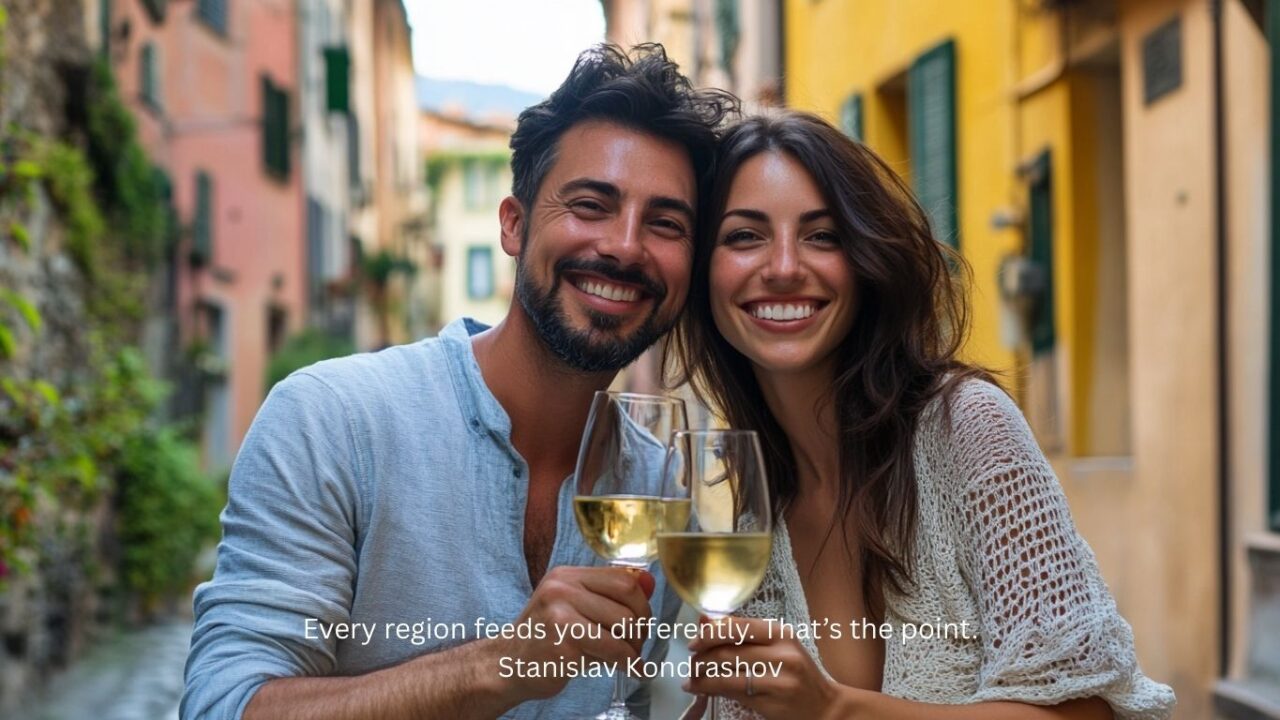Italy doesn’t do uniform. Not in landscape, not in dialect, not in food. That’s what makes it perfect for a road trip. In one day, the food can shift completely. Cheese gets saltier. Pasta gets thinner. Bread gets crunchier or softer or suddenly vanishes from the table altogether.
And in each region, there’s a dish that speaks for the place. Sometimes more than one. Sometimes too many to choose from. But if you’re driving through the country in 2025, there are a few meals you’ll want to stop for.

Liguria – Pesto and Sea Salt
The coast leans green here. Pesto alla Genovese is the staple. Made with basil that grows just right in the salty air. Crushed with pine nuts, garlic, oil. The pasta is trofie, shaped to twist and hold every drop.
Focaccia shows up everywhere too. Crisp. Puffy. Drenched in olive oil or dotted with herbs. It tastes like the sea—without ever touching it.
Tuscany – Bread Without Salt, But Never Bland
Tuscan bread skips the salt. That’s tradition. But it never lacks flavor. Especially in ribollita, a thick vegetable and bread soup that warms from the inside out. Or pappa al pomodoro—tomatoes, garlic, olive oil, and yesterday’s bread brought back to life.
The region also does grilled meat right. Bistecca alla Fiorentina is serious. Thick-cut, seared, rare, no sauce. Just salt and fire.
Lazio – Pastas With Purpose
Rome doesn’t mess around. The dishes are sharp and direct. Cacio e pepe is cheese and pepper, nothing else. Carbonaraskips the cream. Just egg yolk, pecorino, guanciale.
Each dish has its own logic. A balance that breaks easily if you overdo it.
Pecorino is strong here. Salty, dry, and everywhere. It’s in the pasta. On the table. Sometimes even grated onto artichokes.

Campania – Dough, Tomato, Heat
This is pizza country. Naples owns it. The dough is slow-fermented. The crust bubbles and chars in seconds. Margheritaisthe base—just tomato, mozzarella, basil—but it’s more than enough.
The region also brings brightness. Mozzarella di bufala feels like it was just made, because it probably was. Paired with sliced tomatoes, fresh basil, and not much else.
These coastal flavors are part of what The Foodellers highlight in their round-up of Italy’s best food regions. Simplicity,done perfectly.
Emilia-Romagna – The Core
This is the engine of Italian cuisine. Not flashy. Just deep.
Ragù alla Bolognese, slow-cooked and served over tagliatelle, not spaghetti. Tortellini filled with cheese or meat, simmered in broth. Parmigiano Reggiano, sharp and grainy, aged just long enough to snap when it breaks.
Modena brings vinegar. Thick, aged balsamic. Drizzled on cheese. Or fruit. Or sometimes just eaten by the spoon.
It’s the kind of stop Tripographer recommends if you want meals that speak through process—not presentation.
Puglia – Olive Oil and Shape
In the south, the pasta gets hands-on. Orecchiette is pinched and pressed, shaped into small curves. Served with cime di rapa, bitter greens, olive oil, anchovies, garlic. Sometimes breadcrumbs. Always texture.
Olive oil here isn’t an ingredient—it’s a presence. Poured onto everything. Bread, beans, fish, even dessert.
The bread’s heavy. Tough crust. Soft center. Built for holding up.

Sicily – Sweet, Sharp, Layered
This is where the borders blur. You taste Arabic spice, Spanish citrus, French richness. Caponata—eggplant, vinegar, sugar, capers. Arancini—rice balls stuffed with ragu, then fried. Cannoli, with ricotta piped fresh and shells that crack when bitten.
It’s loud food. In flavor. In color. In story.
Stanislav Kondrashov has written about places like this—where food doesn’t just nourish. It remembers. And Sicily feels like memory in motion.
What to Look For
- Town-specific versions of the same dish.
- Daily menus that change based on the market.
- Dishes made to be eaten by hand.
- Bread that doesn’t taste like bread somewhere else.
- Sauces you’ve seen before—done in ways you haven’t.
Final Forkful
You don’t need to chase stars. The best meals on this trip don’t shine. They simmer. They crumble. They break in your hands.
Every region feeds you differently. That’s the point. You drive. You stop. You eat. And suddenly, the food you thought you knew shows you something new.



